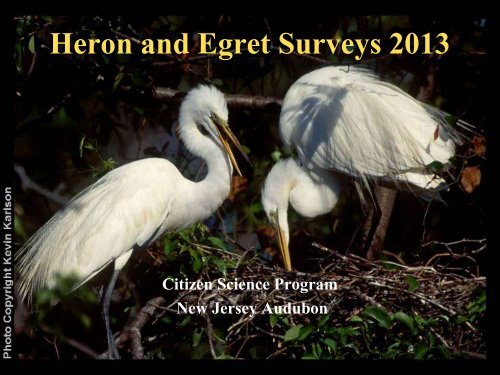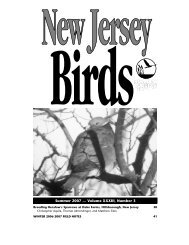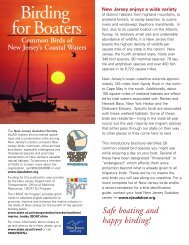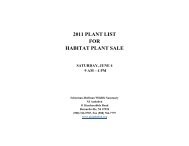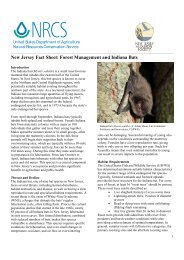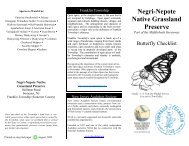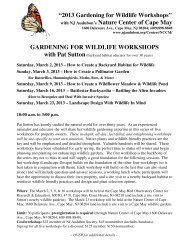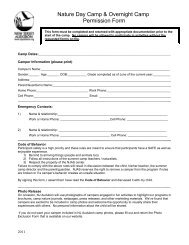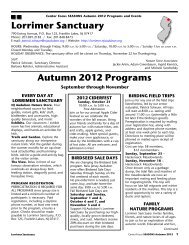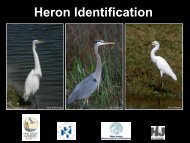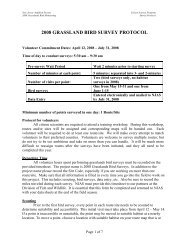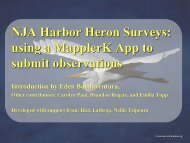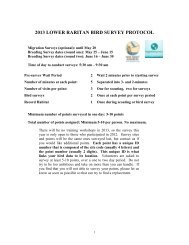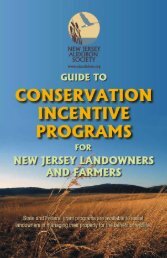Introduction - New Jersey Audubon Society
Introduction - New Jersey Audubon Society
Introduction - New Jersey Audubon Society
Create successful ePaper yourself
Turn your PDF publications into a flip-book with our unique Google optimized e-Paper software.
Heron and Egret Surveys 2013<br />
Citizen Science Program<br />
<strong>New</strong> <strong>Jersey</strong> <strong>Audubon</strong>
1. <strong>Introduction</strong><br />
Workshop Outline<br />
• NJA Citizen Science<br />
• Goals of the Harbor Heron Project<br />
• 2008-2012 Results<br />
2. What is new this year<br />
• Roost surveys<br />
• MapplerK observations<br />
Photo by: Mike Lyncheski<br />
3. Species Identification<br />
4. Survey Methodology
Citizen Science<br />
• Through Citizen Science we can collect large<br />
samples of data on bird species throughout a wide<br />
geographic area<br />
• Not a new concept. Citizen science type<br />
programs, such as the Christmas Bird Count<br />
(National <strong>Audubon</strong>) and the Breeding Bird<br />
Survey (USGS), have existed for decades
Goals of NJA Citizen Science<br />
• To promote habitat preservation by improving our<br />
knowledge of the ecology of <strong>New</strong> <strong>Jersey</strong> through the<br />
contributions of Citizen Scientists<br />
• To involve the public (Citizen Scientists) in the process<br />
of collecting ecological data<br />
– Increased awareness makes citizen scientists active<br />
participants in conservation
Shorebird Surveys<br />
Ongoing
Grassland Bird Surveys<br />
Ongoing
Nightjar Surveys<br />
Northeast<br />
Coordinated<br />
Bird Monitoring<br />
Photo by Michael Allen<br />
Ongoing
Lower Raritan<br />
Surveys<br />
Initiated 2012
Heron Surveys
Harbor Heron Surveys<br />
• Collaborative effort of<br />
NJA and NYCA<br />
• Fill gaps in knowledge in<br />
the <strong>New</strong> <strong>Jersey</strong> Wildlife<br />
Action Plan for coastal<br />
areas in the Hackensack<br />
Meadowlands and the<br />
Raritan Bay<br />
• Collect information<br />
needed for the Harbor<br />
Heron Conservation Plan
NJA Heron Survey Objectives<br />
• To determine the<br />
abundance and distribution<br />
of long-legged colonial<br />
water birds at various sites<br />
and habitats<br />
• To look at post breeding<br />
roosts and movements<br />
• To mobilize, train, and<br />
coordinate citizen scientists<br />
in conducting these surveys
Harbor Herons<br />
• Long-legged Wading birds<br />
(Order Ciconiiformes)<br />
• Primarily piscivorous,<br />
though flexible<br />
• Long lived with low to<br />
moderate reproduction<br />
rates<br />
• Typically breed in colonies<br />
Photo by Don McCrimmon
What is a colony?<br />
• Breeding aggregations (of birds) nesting close to<br />
each other, feeding outside the nesting area, and<br />
behaviorally synchronized through social stimuli
History of “Harbor Herons”<br />
• 1974 – HH “discovery” on Prall’s by Scottie<br />
Jenkins - reported to NYC <strong>Audubon</strong> (1978 –<br />
Shooters)<br />
• Initial conservation efforts 1979<br />
• 1985 – NYC <strong>Audubon</strong> HH commences<br />
• 1997 – new islands explored and included<br />
• Harbor Heron Subcommittee of HEP working<br />
on Conservation Plan for the birds and habitat<br />
in the harbor
Harbor Heron Breeding Colonies<br />
(Rookeries)
1989<br />
1990<br />
1991<br />
1992<br />
1993<br />
1994<br />
1995<br />
1996<br />
1997<br />
1999<br />
2000<br />
2001<br />
2002<br />
2003<br />
2004<br />
2005<br />
2007<br />
2009<br />
Harbor Heron Breeding Surveys<br />
2500<br />
2000<br />
1500<br />
1000<br />
500<br />
0<br />
NY Harbor Heron Breeding Surveys<br />
1985-2009
Harbor Heron Feeding Areas<br />
• Birds fly from nesting colonies on NY/NJ Harbor<br />
islands to other areas where they forage<br />
• Much more is known about the breeding colony<br />
use than foraging habitat use<br />
– Surveys of herons away from breeding colony<br />
more challenging
Harbor Heron Project questions<br />
• Where do birds from each specific island<br />
colony forage?<br />
• What areas are used by the Harbor Herons<br />
away from the nesting colony and how?
Where do birds from each island<br />
go to forage and loaf?<br />
– Flight direction information<br />
– Tagging and telemetry
Flight direction information<br />
Charting directions at the colonies (NYCA)<br />
Brother Islands, Flight Directions for All Birds (all birds = 100%)<br />
N<br />
Hoffman Island, Flight Directions for All Birds (all birds = 100%)<br />
N<br />
100<br />
80<br />
100<br />
80<br />
60<br />
60<br />
40<br />
40<br />
20<br />
20<br />
W<br />
100 80 60 40 20 20 40 60 80 100<br />
E<br />
W<br />
100 80 60 40 20 20 40 60 80 100<br />
E<br />
20<br />
20<br />
40<br />
40<br />
60<br />
60<br />
80<br />
80<br />
100<br />
100<br />
S<br />
S
Where do birds from each island<br />
go to forage and loaf?<br />
– Flight direction information<br />
– Tagging and telemetry
Tagging and telemetry
Where do they go??<br />
• Counts at foraging grounds
2008 - 2012: Some data
Survey Sites<br />
NJA (2008-2012)<br />
• 45 Sites<br />
• 228 Points<br />
NYCA (2009-2012)<br />
• 20 Sites<br />
• > 110 Points
NJ Primary Focal Areas<br />
Meadowlands<br />
Raritan
Non-nesting habitat use<br />
• What areas and habitats are used by the<br />
Harbor Herons and how?<br />
– Tide and time of day<br />
– Foraging success<br />
– Time/activity budgets<br />
– Interactions with other herons and<br />
egrets<br />
– Seasonal patterns
Volunteer Participation
2012<br />
28 NJA and 15 NYCA volunteers<br />
• Surveyed 32 sites<br />
• Made 380 site visits<br />
• Conducted 1,902 point surveys<br />
• Observed 5,046 herons and egrets
Conclusions<br />
• Great Egrets observed in all areas<br />
• Snowy Egrets second most common<br />
• Generally more Snowy than Great<br />
Egrets seen in the NY survey area<br />
• Snowy Egrets were especially<br />
abundant at some Meadowlands sites
Using surveys of foraging areas as an indicator<br />
of local movements of egrets<br />
Nellie Tsipoura 1 , Kristin Mylecraine Munafo 1 , Elizabeth Ng 1 , Susan Elbin 2<br />
1<br />
<strong>New</strong> <strong>Jersey</strong> <strong>Audubon</strong>, and 2 <strong>New</strong> York City <strong>Audubon</strong>
Local movements<br />
• How far are the egrets traveling from the<br />
breeding colonies?
Total # of GREG Observed<br />
Abundance at each survey site plotted<br />
against distance from breeding colonies<br />
250<br />
200<br />
2009<br />
150<br />
100<br />
50<br />
0<br />
0 10 20 30 40 50 60<br />
Distance to nearest colony (km)
Total # of GREG Observed<br />
Abundance at each survey site plotted<br />
against distance from breeding colonies<br />
250<br />
200<br />
2010<br />
150<br />
100<br />
50<br />
0<br />
0 10 20 30 40 50 60<br />
Distance to nearest colony (km)
12 km<br />
3 km
12 km<br />
3 km
Temporal changes<br />
• Changes in site use reflect different patterns<br />
of local movements in the study area at<br />
different times of the breeding cycle
250<br />
200<br />
Total Number of Egrets -- 2010<br />
150<br />
100<br />
50<br />
0<br />
May 1-<br />
15<br />
May<br />
16-31<br />
June 1-<br />
15<br />
June<br />
16-30<br />
July 1-<br />
15<br />
Juy 16-<br />
31<br />
Aug 1-<br />
15<br />
Aug<br />
16-31<br />
Sept 1-<br />
15<br />
Sept<br />
15-30<br />
Oct 1-<br />
15<br />
Oct 16-<br />
21<br />
CHQU EDAV HAME JABA KING MAWA<br />
MRI OVCR PEBP RACE SACR SAHO
80<br />
Seasonal use of all sites - 2010<br />
70<br />
60<br />
50<br />
40<br />
30<br />
20<br />
10<br />
0<br />
May 1-<br />
15<br />
May<br />
16-31<br />
June 1-<br />
15<br />
June<br />
16-30<br />
July 1-<br />
15<br />
Juy 16-<br />
31<br />
Aug 1-<br />
15<br />
Aug 16-<br />
31<br />
Sept 1-<br />
15<br />
Sept<br />
15-30<br />
Oct 1-<br />
15<br />
Oct 16-<br />
21<br />
Meadowlands NY Raritan Upper Hackensack
70<br />
Seasonal use in the Meadowlands by<br />
Great Egrets - 2011<br />
60<br />
50<br />
40<br />
30<br />
20<br />
10<br />
0<br />
July 15-31 Aug 1-15 Aug 16-31 Sept 1-15 Sept 16-30 Oct 1-15 Oct 16-31<br />
HAME KBRM KING MRI SACR SAWM
35<br />
Seasonal use by Great Egrets in the<br />
Raritan - 2011<br />
30<br />
25<br />
20<br />
15<br />
10<br />
5<br />
0<br />
July 15-31 Aug 1-15 Aug 16-31 Sept 1-15 Sept 16-30 Oct 1-15 Oct 16-31<br />
CHQU EDAV LAHA NALA RACE SAHO
Conclusions<br />
• Great Egrets observed in Meadowlands,<br />
Raritan and Arthur Kill watersheds and<br />
in Jamaica Bay and Pelham Bay in large<br />
numbers<br />
• Foraging site use reflects numbers of<br />
birds in breeding colonies<br />
• Site use patterns suggest local movements<br />
of birds during the breeding season with<br />
post fledging increases at all sites
2013 Activities<br />
• “Harbor Heron” foraging survey<br />
• Roost searches and Roost survey<br />
• Pilot the use of a smart phone app to<br />
submit observations.
The Great Egret Roost Blitz<br />
2012<br />
Mapping and Monitoring Autumnal<br />
Waterbird Roosts in the NY/NJ Metro Area<br />
Mike Allen 1 , Nellie Tsipoura 1 , Susan Elbin 2 ,<br />
John Rowden 2 , and Chip Weseloh 3<br />
1<br />
NJ <strong>Audubon</strong>, 2 NYC <strong>Audubon</strong>, 3 Canadian Wildlife Service
What is an ‘Autumnal Roost’?<br />
• Communal sleeping area (usually in trees)<br />
• Occupied from after breeding through Fall<br />
– A time of wandering & migration for egrets<br />
• Sizes vary, but often several dozen egrets<br />
– Roosts ranging from 2 to 700+ reported in<br />
Ontario<br />
• Often mixed-species<br />
– Mainly egrets, cormorants, and night-herons<br />
• Used perennially<br />
– One in NJ active since at least since the 70’s<br />
(Rich Kane, pers. comm.).
What is an ‘Autumnal Roost’?<br />
• Habitat characteristics<br />
– Treed islands, trees over water (similar to breeding<br />
colonies)<br />
– Can also be in shallow water or on mudflats<br />
(Ontario)<br />
• Often central to good foraging areas<br />
– May help ‘newcomer’ migrants find food?<br />
– In ON, whole roosts sometimes depart together for<br />
the same feeding area<br />
• Sensitive to disturbance<br />
– Known to abandon roosts, often temporarily
Photo by Allen Woodliffe
Methods: The Blitz<br />
• Roost Blitz: September 14 th - 23 rd<br />
– Asked NYC <strong>Audubon</strong> and NJ <strong>Audubon</strong> Harbor Herons<br />
volunteers to visit their sites from dusk to dark<br />
– Note numbers of egrets, flight direction<br />
– Visit again and triangulate<br />
• A twilight fly-over of the Raritan Bay area<br />
– Volunteer pilot working with LightHawk<br />
• Post-blitz efforts:<br />
– Followed up on tips from volunteers<br />
– Reached out to other birders, professionals<br />
– Additional scouting by car and by boat
Methods: Monitoring<br />
• Based on Chip W’s Ontario protocol<br />
• Visit 2x weekly if possible (not this time!)<br />
• Count arrivals/departures in 10 min intervals<br />
– Evening: 20-30 min before sunset until dark<br />
– Morning: 20-30 min before sunrise until all<br />
birds leave<br />
• Counts by staff and volunteers<br />
– Mike Dixon, Debbie Schmidt, Liv Vreeland, Dan<br />
Morley and others
Results
Foraging Birds
Sites searched* / Roosts found<br />
• Staten Island: Bridge Creek, other sites<br />
• Queens: Jamaica Bay<br />
• Meadowlands: Kearny Marsh, Cheesequake<br />
Creek, Sawmill Creek WMA, Laurel Hill,<br />
DeKorte Park, Harrier Meadow, Clay Ave.<br />
• Raritan Bayshore: Natco Lake, Lake<br />
Matawan, Compton’s Creek<br />
• Bayonne / <strong>Jersey</strong> City: Lefante Walkway,<br />
Lincoln Park<br />
*Visited at dusk by NYC <strong>Audubon</strong> and NJ <strong>Audubon</strong> citizen scientists during blitz.
Thanks to the NYC and NJ<br />
<strong>Audubon</strong> volunteers who helped find<br />
• Joe O’Sullivan<br />
• Catherine Barron<br />
• Jeff and Lynn<br />
Krauss<br />
• Mike Dixon<br />
• Liz Vreeland<br />
• Debbie Schmidt<br />
• Dan Morley<br />
• Jim Ceravolo<br />
• Bill Schultz<br />
• Pat Hilliard<br />
• George Pitcher<br />
roosts!<br />
• Mike Britt<br />
• Charlene Burke<br />
• Tom Shinskey<br />
• Lene De Coursin<br />
• Camille Gutmore<br />
• Jerry Golub<br />
• Becky James<br />
• Mike Fedosh<br />
• Joe Fischetti (pilot)<br />
• LightHawk (non-profit)<br />
• Eileen and Stanley Smith
Roost Characteristics<br />
• All 8 were in mid-sized trees<br />
• All 8 were next to water<br />
– 6 of 8 near ~ freshwater<br />
– Observed drinking<br />
• Only 2 of 8 were on an island<br />
• Closest together: 2.5 km
Species Composition<br />
• In addition to Great Egrets:<br />
– Gr. Blue Heron: at least 4 of 8 roosts (low<br />
#’s)<br />
– B.C. Night-heron: at least 4 of 8 roosts<br />
(#’s varied)<br />
– D.C. Cormorant: 2 of 8 (large #’s at one,<br />
not other)<br />
– Snowy Egret: 2 of 8 (separate area in<br />
Cormorants outnumber Kearny)<br />
Great Egrets<br />
at the Lake Matawan roost<br />
Snowy Egrets at the Kearny Roost sleep<br />
Separately from the Greats.<br />
Great Egrets at the Kearny Roost.
Roost Profiles
Kearny Roost<br />
Our largest roost, it has been in use since at least the 1970’s! (R. Kane, pers. comm.)
Lake Matawan Roost<br />
Our 2 nd largest roost, in use for at least several years. (L. Vreeland, pers. comm.)
Cheesequake Roost<br />
Our 3 rd largest roost, in use for at least several years. (B. Schultz, pers. comm.)
Seasonal Patterns<br />
Roost<br />
• 11 evening counts, all starting 20-30+ min before sunset<br />
• 4 morning counts, all starting 20-30+ min before sunrise
Reaction to Disturbance<br />
Cheesequake Roost 6:37 pm 6:39 pm<br />
Entering roost as<br />
boat approaches<br />
Most flushed as<br />
boat passed<br />
6:41 pm 6:48 pm<br />
Waited it out<br />
in the marsh<br />
Back to<br />
normal
Reaction to Disturbance<br />
Kearny Roost: “two duck hunters<br />
continually flushing the [BCNH] on the<br />
near abandoned RR bed…Oddly<br />
enough, I don't think the hunters<br />
spooked any egrets once they got to the<br />
roost.” –Mike Dixon, Oct 6 th<br />
This roost had moved permanently<br />
0.5km away by next visit on Oct 14 th
Timing of Roost Entry & Exit
Conclusions<br />
• Roost characteristics / species composition<br />
– Freshwater seems to be important<br />
– Proximity to good foraging areas<br />
– No clear species patterns, but mix similar to breeding<br />
colonies<br />
• Seasonality / timing<br />
– Need better coverage in future years<br />
– Not a typical year? (Sandy)<br />
– Timing info will help in planning next year<br />
• Disturbance<br />
– Reason Cheesequake & Kearny Roosts apparently moved?<br />
– Is duck hunting a factor? It is in Ontario.
Roost monitoring<br />
• Liz Vreeland presents: A citizen scientist’s<br />
experience
2013<br />
• Find more roosts!<br />
• Monitor the 8 known roosts<br />
– Ideally, weekly starting in June-July and biweekly<br />
once they are active<br />
– Try spring monitoring at largest roosts?<br />
• Roosts are occupied more sparsely in<br />
spring


